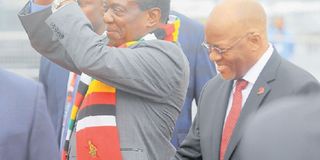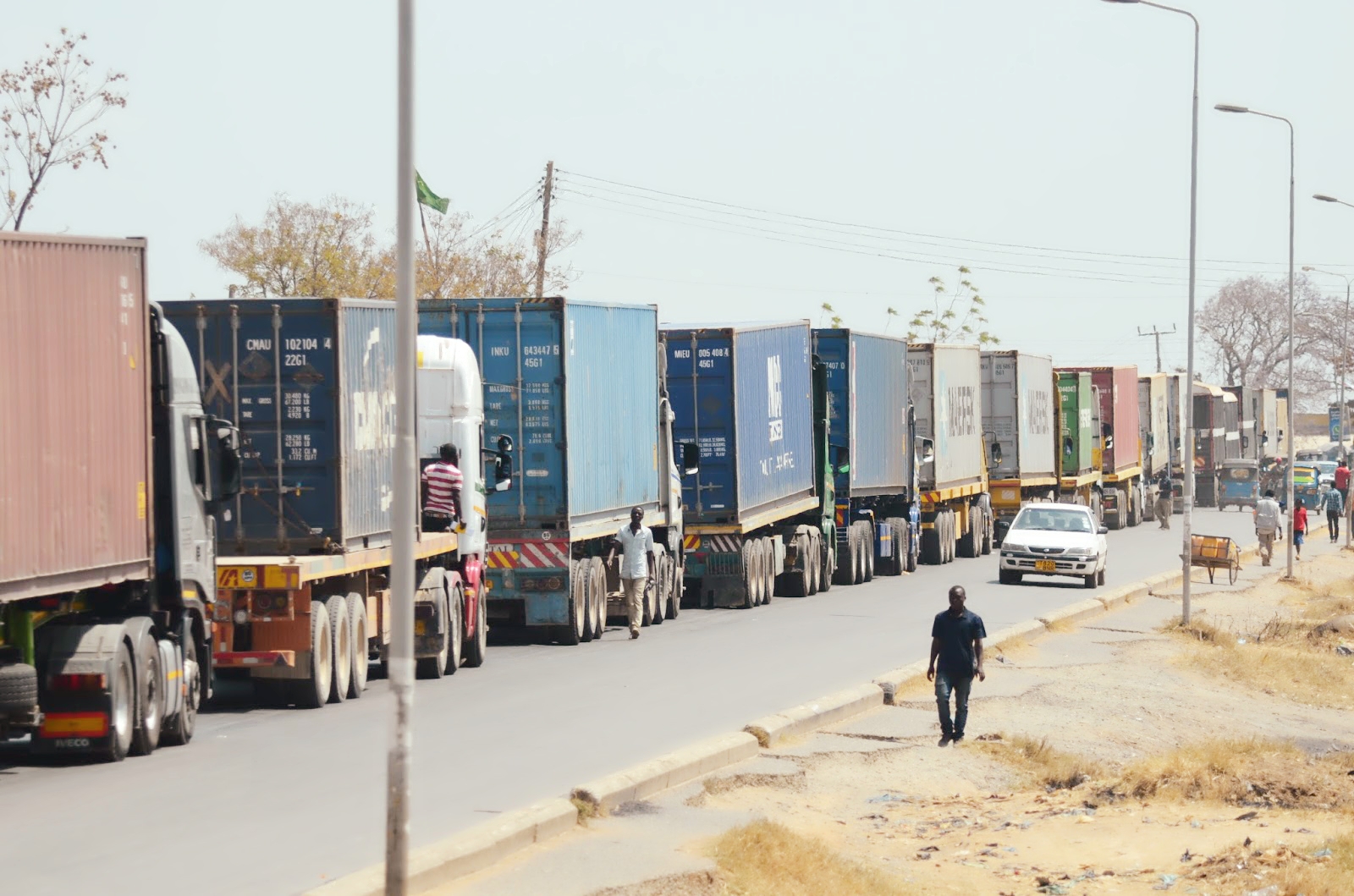Why Bagamoyo has centre stage in Zimbabwe’s political transition

President John Magufuli with his Zimbabwean counterpart Emmerson Mnangagwa in Dar es Salaam last week. The Zimbabwean leader was in Tanzania for a two-day state visit during which he visited Bagamoyo where he underwent military training in the early 60s. PHOTO|FILE
What you need to know:
For this, Bagamoyo has remained a place of emotion. A place of emotion for many Africans – and decades after the end of slavery, for many who left their homes to fight for freedom – liberation from the chains of colonial subjugation.
Dar es Salaam. Thousands of years ago, they bore a cruel fate in a place of scorching heat. Captured by the ‘devil incarnates’, they were chained together and walked hundreds of kilometers to this place. Millions of them shipped from here to suffer slavery.
For this, Bagamoyo has remained a place of emotion. A place of emotion for many Africans – and decades after the end of slavery, for many who left their homes to fight for freedom – liberation from the chains of colonial subjugation.
The high-profile names that quickly come to mind from southern Africa are those of Mozambique presidents Joaquim Chissano and Samora Machel, as well as Zimbabwean President Emmerson Mnangagwa.
These prominent revolutionaries passed through Bagamoyo in their quest for the liberation of their countries and were among 59 cadres from Frelimo (Mozambique), six from Southern Rhodesia (now Zimbabwe) and five from South Africa, who underwent military training at a camp in the small town 75 km out of Dar es Salaam.
For the Zimbabwean President, it was an emotional trip down memory lane last week when he visited one of the places of his beginnings as an African liberation fighter.
On the second day of his two-day state visit to Tanzania, Mr Mnangagwa was in Bagamoyo where he toured the first military camp in the area – the place that gave him and fellow cadres the emotionally significant embrace they desperately needed in their quest to dislodge the brutal Ian Smith regime back home.
Tanzania provided one of the initial bases of the liberation movement in Zimbabwe (then Rhodesia).
Mr Mnangagwa is said to have arrived in Tanzania through the Bagamoyo training camp in 1963. The camp was Mozambique liberation movement Frelimo’s headquarters then.
Back home two years later, he was among the first liberation combatants to operate in Rhodesia. He was arrested and jailed in January 1965 after blowing up a locomotive near Masvingo – a province in south-eastern Zimbabwe and home close to Great Zimbabwe, the national monument from which the country takes its name.
However, he escaped the mandatory death sentence by a whisker because he was underage, although he served a 10-year sentence at Khami Maximum Prison near Bulawayo – Zimbabwe’s second largest city – before being deported to Zambia upon his release.
Special assistant
In Zambia, he worked with Kenneth Kaunda’s Unip party and practised law, and was appointed Robert Mugabe’s special assistant at his party (Zanu PF)’s Chimoio congress in 1977.
The two worked side by side since 1980 when Zimbabwe got its independence. He was in Mr Mugabe’s government ever since – until last November when with the help of the army, he took over power from his mentor, citing incapacity to continue leading. Speaking during his tour of the Bagamoyo site, the Zimbabwean President said he was “extremely grateful” to be back in the area 58 years after his year-long stint at the camp.
“We were 59 comrades of Frelimo, five comrades from Rhodesia – now Zimbabwe – and six comrades from South Africa; this was around May-June in 1963, which is now 58 years ago.
“The local population was very kind to us and assisted us in many ways. May I thank the government of Tanzania and Mozambique for preserving this historic place.”
Kaole Wazazi College of Agriculture has since been built on the site.
Cadres who volunteered to join the war, the Zimbabwean state-run Herald reported, President Mnangagwa did not do so for financial gain, but were driven by a commitment to free their countries from colonialism.
Road to independence
According to President Mnangagwa, the road to independence was long and arduous.
“It’s a long, long, arduous road – the struggle,” he said. “Again, I must say we should not focus on me; focus on everybody who travelled this arduous road to independence.”
Leadership, he said, was a reward for commitment, honesty and hard work. “You can pass thorough State House the entirety of your life, but I can assure you that someone (travelling) on foot to China, will reach China on foot (and) you will still be passing by State House without getting in,” he said.
“So, it is a system, a structure, a process, where through your sacrifice, your commitment, your perseverance and consistency in the revolution that the people recognise you and reward you stage by stage, step by step as you discharge those responsibilities with commitment and honesty and hard work.”
The Head of State and Government also donated $10 000 to Kaole Wazizi College of Agriculture.
President Mnangagwa on Thursday described Tanzania, which got its independence from Britain on December 9, 1961 and was part of the Frontline States, as a midwife of the liberation movements on the continent.
“Tanzania is the midwife of our freedom,” he said. “It is our duty, we of the older generation, to teach that legacy. Tanzania must be understood and cherished by the younger generation.”
The Zimbabwean leader’s visit to Tanzania came a few days after he survived an assassination attempt that he blamed on a Zanu-PF faction that was reportedly led by former President Mugabe’s controversial wife Grace.
In a meeting with Zimbabweans in Tanzania, he is said to have downplayed the attempt on his life saying there would not be any security crackdown ahead of the country’s harmonised election on July 30.
Interestingly, Bagamoyo may in the foreseeable future continue claiming the centre stage in Zimbabwean politics – at least as long as the country’s liberation war heroes are at the helm of power.
At the height of the battle pitting the ruling party’s two main factions jostling to succeed the aging Mugabe last year, Bagamoyo popped up when the question of seniority among the competing cadres was posed.
Heated debate within Zanu PF as to who was senior in terms of history and arrival at liberation struggle front and bases between then Vice-President Mnangagwa and then Defence minister Sydney Sekeramayi centred on Bagamoyo.
The Defence minister – who was said to be aligned to the G40 faction led by the then-First Lady Grace Mugabe – was at a certain point among the favourites to succeed the Zimbabwean strongman.
That dreamed vanished with the brief November 15 military takeover. But according to a report in the Zimbabwe Independent last year, there had been an argument as to the military seniority of the two cadres based on who arrived in Bagamoyo first.
There was a group that suggested the former Defence minister arrived in Tanzania earlier than Mr Mnangagwa – who got to Bagamoyo in 1963.
The Zimbabwe Independent cited Mr Sekeramayi’s parliamentary profile, saying on December 28 1961, with the assistance of Mugabe, he left the country to Tanzania and then overseas to join the struggle and in pursuit of further education.




